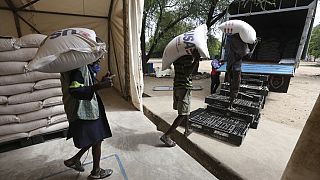Kenya
Life is getting tricky for these Angolan colobus monkeys.
They are arboreal, living in territorial groups high above the ground.
They feast on leaves and rarely descend to the ground, using the trees as trampolines to travel, but the African Wildlife Service says they will come down if the trees aren't dense enough to support and they're forced to forage below.
There are two species of colobus monkeys in Kenya: Angolan black-and-white colobus (Colobus angolensis) and Eastern black-and-white colobus (Colobus guereza).
It is not yet endangered, but according to the international conservation group, the IUCN, population numbers are going down.
As Diani becomes more populated and more attractive to tourists, the amount of development and traffic increases.
But there are also other threats to this primate, its striking fur has made it attractive to hunters.
Susan Rose Maingi is the manager at the Conservation and Primate Rescue Centre in Diani.
"The numbers of these species are few, there are about 5,000 in Kenya, approximately 3,000 to 5,000, and that makes them vulnerable to extinction, such that, as we have more deforestation, conversion of land uses, their habitats get restricted and they are not able to move or to find food or resources and eventually it is easier for them to get extinct as they are in these pockets and they cant really interbreed. They can't meet other populations, can't meet each other so in that situation where you have fragmented populations, it is easier to lose them to extinction," she says.
Maingi says there are already pockets of Kenya where the monkey is no longer found.
"In the 70s we saw a reduction in population to near local extinction in the north of Mombasa and the north coast of Kenya. This mainly is due to overhunting of the species for their beautiful black and white pelts. Their skin was used for traditional practices, it was a symbol of power and superiority in many of our African cultures and this has led to their local extinction so you will not observe Angolan Colobus north of Mombasa. They are only found in Kwale county."
Electrocution is an unfortunate fate that faces a growing number of monkeys.
In order to get past busy traffic, some will clamber across powerlines.
"We receive up to two calls a month of different monkey species particularly the colobus that have been electrocuted or experience injuries due to electric shock," says Maingi.
The conservation group tries to save the electrocuted monkeys, but this isn't always possible.
Maingi says: "In several cases unfortunately we lose the animal to electrocution and this is because the lines are largely uninsulated, so to address this we work with relevant government agencies that are in charge of power supply here to address this challenge by insulating power lines particularly in the Diani area and in the new sections of Diani that are being developed as we see the increase of tourism and the increase of people basically as the city becomes bigger."
The conservationists are hoping the tourism will bring interest in the welfare of the wildlife here, as well as increasing the human population and building developments and it looks like they've succeeded with this group of visitors.
Visitor Ted Lawrence says "Seeing the colobus monkeys was amazing, beautiful animals. Of course protecting them and other animals is part of biodiversity and having healthy ecosystems so the protection here of these animals is critical to the overall biodiversity of our ecosystems which of course support humans so we have to have that natural balance."
A 2019 report by Colobus Conservation noted deforestation is causing a slow but gradual decline in the population of colobus monkeys within their range, with over 80% of the coastal forests already lost.












02:14
Scientists find way to identify elephant ivory disguised as legal mammoth ivory
01:51
In this Moroccan crocodile park, children learn about the environment
01:34
EU commits €1 billion to protect oceans under a new pact
01:05
Zimbabwe to cull 50 elephants, distribute meat to locals
00:50
New documentary shines light on plight of pangolins, one of the world's most trafficked mamals
01:45
How cutting off rhino horns might help curb poaching